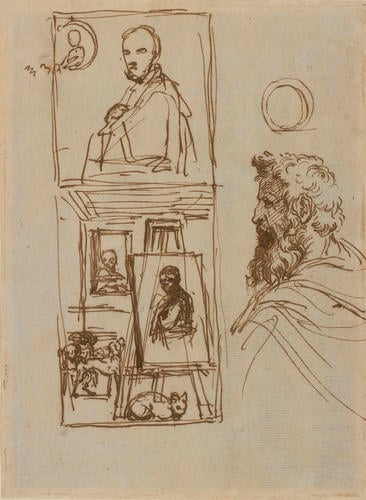-
1 of 253523 objects
A self-portrait on an easel c. 1603-05
Pen and ink | 24.5 x 18.0 cm (sheet of paper) | RCIN 901984

Annibale Carracci (Bologna 1560-Rome 1609)
A self-portrait on an easel c. 1603-05

Annibale Carracci (Bologna 1560-Rome 1609)
A self-portrait on an easel c. 1603-05


-
Here Annibale Carracci (see RCIN 902254) is experimenting with differing levels of illusion in a self-portrait. The lower composition shows a canvas bearing a self-portrait, set up on an easel in an interior; to the left is what may be a mirror on the far wall of the room, reflecting the image of the artist (and thus the viewer) back at himself. One of a group of dogs looks up towards the canvas, implying that the image is so lifelike that the animal believes it to be his master, and a cat at the lower edge of the composition would, in the finished painting, appear to be seated ‘on’ the frame.
The upper composition studies in more detail the portrait to be depicted on the fictive canvas, with the sitter half-length and turned to the left, a cloak over his shoulder. At upper left is presumably a circular mirror, again reflecting the artist/viewer. The man sketched to the right of the sheet may simply be an unconnected doodle, though it has been claimed that he represents Michelangelo, whose Sistine ceiling was the inspiration for Annibale’s greatest work, the ceiling of the Galleria in Palazzo Farnese, Rome.
The drawing is a study for a small painting known in two versions, in St Petersburg (Hermitage) and Florence (Galleria degli Uffizi), whose precedence is disputed. The composition of those paintings is significantly less sophisticated than the drawing in its manipulations of levels of reality. In the paintings the artist is shown in isolation on the fictive canvas, bust-length and looking out at the viewer. In an otherwise featureless dark room, the mirror is replaced by an open window before which stands an ill-defined manikin; a dog and cat behind the legs of the easel simply look out of the picture at the viewer.
The painting was executed in the latter years of Annibale’s life, after he had completed the ceiling of the Galleria Farnese. That work had exhausted him and the lack of appreciation from his patron, Cardinal Odoardo Farnese, had left him despondent. But throughout his life Annibale had esteemed his painter’s craft above all other (especially courtly) accomplishments, and the drawing and painting perhaps reflect his fervent belief in the importance and nobility of his art over worldly and quotidian concerns.
Text adapted from Portrait of the Artist, London, 2016Provenance
Probably acquired by George III in 1762 as part of the collection of Cardinal Alessandro Albani; first recorded in a Royal Collection inventory of c. 1800-1820
-
Medium and techniques
Pen and ink
Measurements
24.5 x 18.0 cm (sheet of paper)
Object type(s)
Other number(s)
RL 1984